Sample itineraries and maps are for illustrative purposes only, and the exact route and sites visited may change based on local regulations, guest experience, weather, and logistics, at the Captain’s discretion.
Visayas Southern Leyte & Malapascua (Mactan – Mactan)
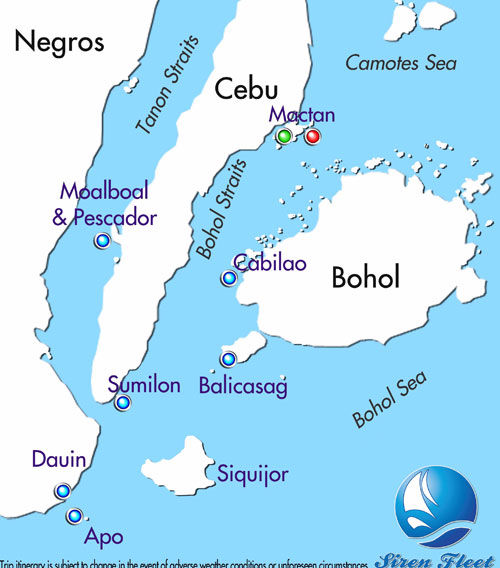
Day 1: Embarkation at 13:00
IMPORTANT NOTE: Strict adherence to the embarkation time is crucial. Please arrive at the port before 13:00H. After checking in and the safety briefing, the vessel will pull anchor and set sail.
Days 2-9: Up to 4 dives (3-day dives and a sunset or night dive), typically scheduled as follows:
- Light Breakfast followed by a briefing and Dive 1
- Full Breakfast, relaxation period, briefing, and Dive 2
- Lunch, relaxation period, briefing, and Dive 3
- Snack relaxation period, briefing, and Dive 4, where possible
- Dinner
Day 10: Maximum 2 dives
Day 11: Disembarkation at 10:00
Embarkation is normally at 13:00, but can sometimes differ. Double-check your cruise confirmation for the exact time. Disembarkation at the end of the cruise will be just before 10:00, though you may be able to disembark earlier depending on your return flight arrangements. Please note this may affect the number of dives you can make on your final cruise day.
An early departure must be confirmed with our office prior to booking your flights. If traveling onwards on the same day, please allow plenty of time for transfer to international terminals and check-in.
Tubbataha & More (Mactan – Puerto Princesa)

The Philippines comprises over 7,600 islands, surrounded by deep blue seas that contain some of the richest marine life on earth. Considered by many to be the apex of the Coral Triangle, scuba diving in the Philippines offers a wide variety of marine environments to choose from.
Whether it’s dives on steep walls and offshore pinnacles, critter hunting in coastal reefs, the sardine run, or the opportunity to get up close to the world’s largest fish – the whale shark, the Philippines will whet the appetite of even the most seasoned diver.
Sample Itinerary
Day 1:
Embarkation at 13:00.
Days 2-12:
Up to 4 dives (3 day dives and a sunset or night dive), typically scheduled as follows:
- Light Breakfast followed by a briefing and Dive 1.
- Full Breakfast, relaxation period, briefing, and Dive 2.
- Lunch, relaxation period, briefing, and Dive 3.
- Snack relaxation period, briefing, and Dive 4, where possible.
- Dinner.
Day 12:
Maximum 2 dives.
Day 13:
Disembarkation at 10:00.
The last dive will be on the penultimate day of the trip. Divers are recommended to wait for 24 hours before flying after the last dive.
(*) The itinerary description is provided by the boat operator.
Tubbataha (Puerto Princesa – Puerto Princesa)

North Atoll
- Gorgonian Wall: This breathtaking dive site is known for its steep, coral-covered walls and thriving marine biodiversity. The site features large gorgonian sea fans, whip corals, and barrel sponges, creating a stunning underwater landscape with visibility typically ranging from 15 to 30 metres, providing clear views of the vibrant reef. Starting at around 10 metres, the wall drops off into the deep, offering a dramatic vertical dive. Moderate to strong currents attract pelagic species, making it an exciting drift dive. Expect to see schools of trevally, barracuda, and snapper patrolling the reef, along with whitetip reef sharks, grey reef sharks, and manta rays. Green sea turtles also often visit the reef to feed.
- Washing Machine: Famous for its changeable currents, Washing Machine is one of the most exhilarating dive sites in Tubbataha, with countercurrents converging around the exposed northeastern tip of North Atoll, creating a temporary washing machine-like vortex. While this may sound intimidating, we normally try to dive here when there is minimal current, though conditions can still be unpredictable. Our dive guides have plenty of experience leading divers through this area, making it safe and fun for those comfortable in stronger currents. Once past the swirling zone, the drift becomes smoother, and divers are treated to spectacular reefscapes teeming with life and opportunities for action-packed encounters. The nutrient-rich currents support a wide variety of marine life and bring plankton and baitfish, attracting larger predators. Common sightings include schooling jacks, snappers, barracuda, manta rays, eagle rays, grey reef sharks, whitetip reef sharks, and sometimes even hammerhead sharks.

- Shark Airport: A signature dive of Tubbataha itineraries, the star attraction of Shark Airport is its shark population. Featuring a wide, coral-covered plateau at around 15 metres, which drops off to a shelf at 25 metres, this exciting dive site is so called because whitetip reef sharks are often seen resting on the sandy bottom, resembling planes parked on a runway. Grey reef sharks are also common here, often patrolling the reef wall in groups. Other marine life includes dogtooth tuna, schools of trevally, marble rays, eagle rays, nurse sharks, Napoleon wrasse, and groupers.
- North East Wall: The North East Wall offers a thrilling combination of spectacular vertical drops, rich coral growth, and encounters with large pelagics, and is a true showcase of Tubbataha’s legendary beauty — a place where you can feel the raw energy of the open sea while being surrounded by pristine reef life. As its name suggests, the wall runs along the northeast side of the atoll, directly facing the open Sulu Sea, meaning it’s exposed to nutrient-rich currents that fuel an incredibly diverse and abundant marine ecosystem. The top of the reef offers a colourful coral garden, but most divers soon venture over the edge, where the wall plummets dramatically into the blue. Adorned with stunning sea fans, sponges, and colourful coral bushes, this site is a favourite among photographers and big-fish enthusiasts due to the frequent sightings of sharks, rays, turtles, and schooling fish, all against a backdrop of an epic underwater cliff face.
![]()
- South Park: South Park is usually one of the more relaxed dive sites on the North Atoll compared to some of Tubbataha’s high-adrenaline walls and drift sites. Featuring a shallow coral plateau that gently slopes downward, transitioning to a wall, vibrant coral gardens, and excellent marine biodiversity, currents here are generally manageable but can sometimes pick up, providing a gentle drift along the slope or wall. The reef structure is rich and varied, with sandy patches, coral bommies, and mini walls adorned with hard and soft corals. The mix of macro life with mid-size predators makes it an exciting dive for both wide-angle and macro enthusiasts. Green turtles and hawksbill turtles are commonly seen grazing or resting, while schooling fusiliers, snappers, and rainbow runners swarm over the reef. Other regular encounters include grey and whitetip reef sharks, Napoleon wrasse, and a variety of stingrays.
- Amos Rock: Also known as Southwest Rock, Amos Rock is arguably one of the most iconic and celebrated dive sites in the Tubbataha Reefs Natural Park. Located off the northwestern tip of the North Atoll, the dive site offers a breathtaking combination of dramatic wall topography, nutrient-rich currents, lush coral coverage, and outstanding marine life. Named after a local ranger, this site is famous for thrilling drifts along vertical walls, massive schools of fish, frequent shark sightings, and pristine hard and soft coral gardens. Known for its stunning coral formations, huge gorgonian fans, massive barrel sponges, and black coral bushes, currents are a major part of the Amos Rock experience. Typically flowing along the wall, the current can vary from a gentle drift to a strong ride, turning the dive into an exhilarating underwater ‘flight.’ Every few metres, the scenery changes from vibrant coral overhangs to dramatic crevices, and all the while, the blue water around you is teeming with action.
![]()
- Malayan Wreck: The Malayan Wreck dive site is a vibrant fusion of natural and artificial reefs, often described as one of the more mystical sites in Tubbataha due to the moody silhouette of the wreck and the abundance of life sheltering in and around it. Starting between 5-10 metres, the reef features a gentle coral slope that transitions into a steep vertical wall beyond 20 metres, with the remains of the Malayan partially embedded into the slope between 15 and 25 metres. It’s a great site for macro and wide-angle photography, with moray eels tucked into crevices within the wreck, nudibranchs, shrimps, crabs, pipefish, and seahorses amongst the corals and sponges. Schooling bannerfish, fusiliers, and anthias populate the reefs, with plenty of pelagic action. Adjacent to the wreck, the Malayan Wall is a deep drop-off where whitetip and grey reef sharks are regularly spotted, along with giant trevallies, dogtooth tuna, blackfin, yellowfin, and bigeye barracuda. Occasionally, schools of hammerhead sharks can also be seen.
- Wall Street: Wall Street is a beautiful and serene dive that offers everything from dramatic topography to thrilling wildlife encounters. Typically dived as a drift, it’s one of the classic Tubbataha sites that showcases the health and beauty of this remote marine sanctuary. Depending on the current, there are many opportunities to pause and observe the small details or just hang midwater and take in the scenery. The drop-off here is breathtaking and offers a sense of flying along a cliff face underwater. As you glide along the wall, you’ll encounter a tapestry of colourful corals, ledges, and overhangs, many of which hide moray eels, lionfish, and crustaceans. You’ll often spot schools of reef fish hugging the wall while your peripheral vision catches movement in the deep blue: reef sharks, barracuda, and sometimes manta rays or whale sharks passing by.
![]()
South Atoll
- Black Rock: While Black Rock may not boast the most extensive coral coverage compared to other sites in Tubbataha, its appeal lies in the abundance and diversity of marine life. The combination of a sloping plateau and steep walls provides an ideal setting for observing both reef dwellers and pelagic visitors. The site’s location and conditions make it a favourite among divers seeking encounters with larger marine species in a relatively tranquil environment. Currents can be strong and changeable, which fuels an environment bursting with large schools of fish, shark activity, and occasional pelagic visitors.
There is so much to explore at this dive site that we will often spend a whole day diving here. Schools of surgeonfish, rainbow runners, and sweetlips are a common sight. Whitetip and nurse sharks are found resting under huge table corals, and scribbled filefish, boxfish, and leaf fish add to the colour and spectacle of the stunning reef — a great site for spotting spiny lobster too.
- Delsan Wreck: Named after the remnants of a small fishing vessel that sank during a storm, Delsan Wreck offers a dynamic diving experience, combining the intrigue of a shipwreck with the allure of vibrant marine ecosystems. The site’s topography includes sloping reefs and coral formations that provide habitats for a multitude of species. “The Cut,” a 30-metre deep by 20-metre wide crevasse in the coral, serves as a natural channel where predators often hunt, offering thrilling encounters for divers. Currents can vary from mild to strong, often enhancing the presence of pelagic species.
Grey reef sharks and whitetip reef sharks, schools of rainbow runners, and different species of barracuda, trevallies, snappers, groupers, fusiliers, and sweetlips are just a few examples of the marine life that fill this amazing dive site with colour and vitality.
![]()
- Triggerfish City: Triggerfish City offers a high-energy, visually rich dive with constant activity. True to its name, the site is famous for its large populations of triggerfish, with prolific numbers of red-toothed triggerfish swirling above the reef in large, synchronised schools. Yellowmargin and clown triggerfish are also common, as well as territorial Titan triggerfish, especially during nesting season when they aggressively guard their conical nests on the seafloor.
The reef begins at a depth of 5 metres and is adorned with sparse staghorn corals, providing a habitat for an array of colourful reef fish. From the reef top, the underwater landscape transitions into a wall that gradually leads down to a sandy bottom, reaching depths of 12–14 metres and adorned with barrel sponges and sea fans. On the eastern side, the wall steepens, plunging to an impressive depth of 50 metres.
This dive offers an exhilarating drift experience, where divers may witness schooling juvenile grey reef sharks, whitetip sharks, barracudas, turtles, oriental sweetlips, and various grouper and snapper species residing on the rocky reef ledges.
- Staghorn Point: Staghorn Point offers a serene and visually stunning diving experience. As its name suggests, this dive site is characterised by its vast expanses of staghorn coral, which create a complex and intricate reef structure with a rich mix of reef-associated species, occasional pelagics, and vibrant coral dwellers. These coral fields provide shelter and breeding grounds for a multitude of reef fish, including anthias, chromis, and damselfish, creating a vibrant and dynamic underwater scene. As the reef extends seaward, it transitions into a steep wall adorned with various coral formations, sponges, and sea fans. Green turtles are often seen feeding on soft corals and resting on the reef, and whitetip reef sharks can be seen cruising along the deeper wall sections.
![]()
- Southwest Wall: Southwest Wall is a spectacular dive site known for its dramatic drop-off, vibrant reef life, and regular pelagic sightings. A narrow coral plateau leads abruptly to a sheer, vertical wall, richly decorated with gorgonian sea fans, barrel sponges, and soft corals. As divers descend along the wall, they’ll find overhangs, small caves, and crevices, which provide shelter for resting whitetip reef sharks and a whole host of reef and cryptic species.
As with many of Tubbataha’s dive sites, grey reef sharks are a common sight here, along with schools of bigeye barracuda, trevallies, and dogtooth tuna. The reef is densely populated by anthias, butterflyfish, and wrasses weaving through the coral structures and abundant parrotfish, moorish idols, and angelfish along the upper slope. Look closer and you’ll find nudibranchs, shrimp, leaf scorpionfish, and blennies tucked into coral crevices. - Ko-Ok: Ko-Ok is a stunning diving site featuring a broad, sandy-terraced reef top that starts at depths of about 3–8 metres and slopes to 18 metres before dropping into a steep wall. The reef features a flat coral plateau interspersed with sandy patches and scattered bommies on the shallow slope, transitioning to a wall adorned with large sponges and gorgonian fans. Ko-Ok is famous for its massive fish shoals, including swirling schools of bigeye trevally and fusiliers. Other regular encounters include bigeye barracuda, dogtooth tuna, reef sharks, bumphead parrotfish, giant moray eels, and hawksbill turtles, and occasionally hammerhead sharks. Currents at Ko-Ok are usually moderate but can become strong during swells.
Jessie Beazley Reef
![]()
- Jessie Beazley Reef is a spectacular microcosm of everything that makes Tubbataha Reefs Natural Park so extraordinary: wild, beautiful, and untouched. Located about 20 kilometres north of Tubbataha’s North Atoll, this small, isolated seamount is capped by a sandy cay with impressive walls plunging to abyssal depths. Because of its remote location and strong surrounding currents, it enjoys some of the healthiest coral coverage in the entire area.
The reef is famous for its pristine coral gardens, exquisite marine biodiversity, huge schools of pelagic fish, and the occasional big pelagic visitor. Rich in various coral species, including enormous table corals, brain corals, and fields of staghorn corals, marine life includes whitetip reef sharks, blacktip reef sharks, whale sharks, hammerheads, bull sharks, manta rays, and a variety of reef fish.
We mostly dive around and between the corners along the east side of Jessie Beazley Reef, which boasts a perfect blend of lush reefscapes, exciting drifts, stunning macro life, and big animal encounters. The choice of where we dive on each trip is determined by the currents, and each section offers a slightly different flavour of diving, from colourful coral gardens to fast-paced shark-filled expressways.
Sample Itinerary:
Day 1:
- Embarkation from Baywalk Pier at 13:00. Once on board, lunch will be served, followed by a mandatory briefing from the Tubbataha Management Office and a check conducted by the Coast Guard before the boat can leave port. There is no diving on embarkation day.
Days 2-5
- Your Cruise Director will schedule up to 4 dives per day; 3 day dives and a sunset dive, typically as follows:
- Light Breakfast followed by a briefing & Dive 1
- Full Breakfast, relaxation, followed by briefing & Dive 2
- Lunch, relaxation,n followed by briefing & Dive 3
- Snack
- Briefing for Sunset dive (no night dives)
- Dinner
In accordance with Tubbataha Marine Park regulations, dive times are limited to a maximum of 60 minutes.
![]()
Day 6:
- Two morning dives* in Tubbataha National Park before Philippine Siren commences the 12-16 hour crossing back to Puerto Princesa.
Day 7:
- Following breakfast on board, disembarkation between 09:30 and 10:00.
IMPORTANT NOTE: Strict adherence to the embarkation time is crucial. Please arrive at the port before 13:00H. After checking in and the safety briefing, the vessel will pull anchor and set sail.
The last dive will be on the penultimate day of the trip. Divers are recommended to wait for 24 hours before flying after the last dive.
Tubbataha & More (Puerto Princesa – Mactan)
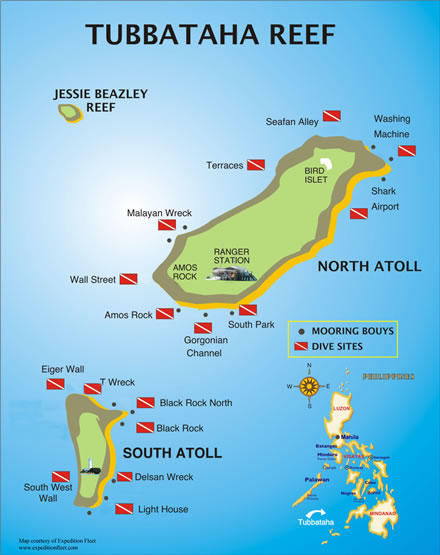
Day 1: Embarkation at 13:00
IMPORTANT NOTE: Strict adherence to the embarkation time is crucial. Please arrive at the port before 13:00H. After checking in and the safety briefing, the vessel will pull anchor and set sail.
Days 2-12: Up to 4 dives (3-day dives and a sunset or night dive), typically scheduled as follows:
- Light Breakfast followed by a briefing and Dive 1
- Full Breakfast, relaxation period, briefing, and Dive 2
- Lunch, relaxation period, briefing, and Dive 3
- Snack relaxation period, briefing, and Dive 4, where possible
- Dinner
Day 13: Maximum 2 dives
Day 14: Disembarkation at 10:00
Marine Life: Thresher Sharks, Manta Rays, White Tips, Turtle, Frogfish, Pipefish, Nudibranchs, Flamboyant Cuttlefish, Mandarin Fish, Whale Sharks
Please note the following:
- In Tubbataha, diving conditions are not suitable for beginners: strong currents, wall dives, etc. Therefore, we recommend all divers to have logged a minimum of 30 dives. It is not allowed to bring or fly drones in the Tubbataha Natural Park.
- The last dive of the trip will be on the penultimate day. Divers are recommended to wait for 24 hours before flying after the last dive.
Southern Visayas (Mactan – Moalboal)
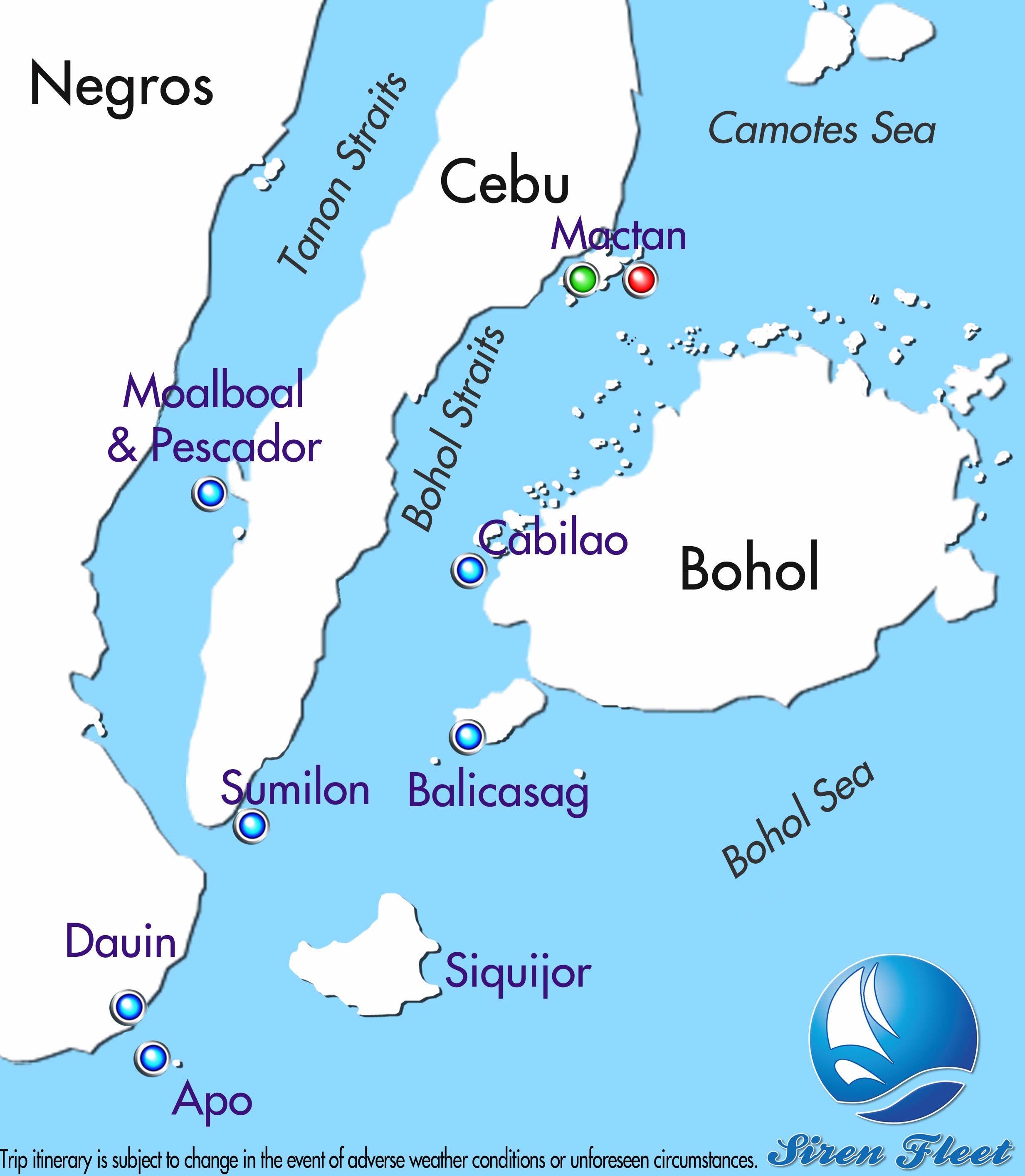
The following is a sample itinerary of dive sites we may visit during your liveaboard cruise with the Philippine Siren. We wish to show you the very best diving possible, however, a number of factors determine which route the yacht takes and which dive sites we visit. Weather, tides, currents, and the number of other dive vessels at a particular site all play a part in the Cruise Director’s decision of where the Philippine Siren is heading to. This itinerary involves some long-distance travel. Whilst we attempt to ensure the number of dives we have scheduled is fulfilled bad weather can hinder the yacht’s ability to reach a specific dive site in good time. The safety of our guests onboard is paramount and we always do our best to offer diving at alternate locations, should we be unable to visit those sites listed below.
IMPORTANT NOTE: Strict adherence to the embarkation time is crucial. Please arrive at the port before 13:00H. After checking in and the safety briefing, the vessel will pull anchor and set sail.
Your Cruise Director will schedule up to 4 dives per day; 3-day dives and either a sunset or a night dive. A typical diving day is scheduled as follows:
- Light Breakfast followed by a briefing & Dive 1
- Full Breakfast, relaxation followed by briefing & Dive 2
- Lunch, relaxation followed by briefing & Dive 3
- Snack
- Briefing for Sunset dives or night dives
- Dinner
Generally, we schedule 2 dives on your final dive day in order to allow enough time for off-gassing. To remain on the safe side, we kindly request our guests to check their own flight times and ensure that they leave a minimum of 24 hours between their final dive and their return flight. Guests are welcome to suggest preferred dive sites to the Cruise Director. He/she will be happy to accommodate guests’ wishes, providing it is possible and the schedule allows for it.
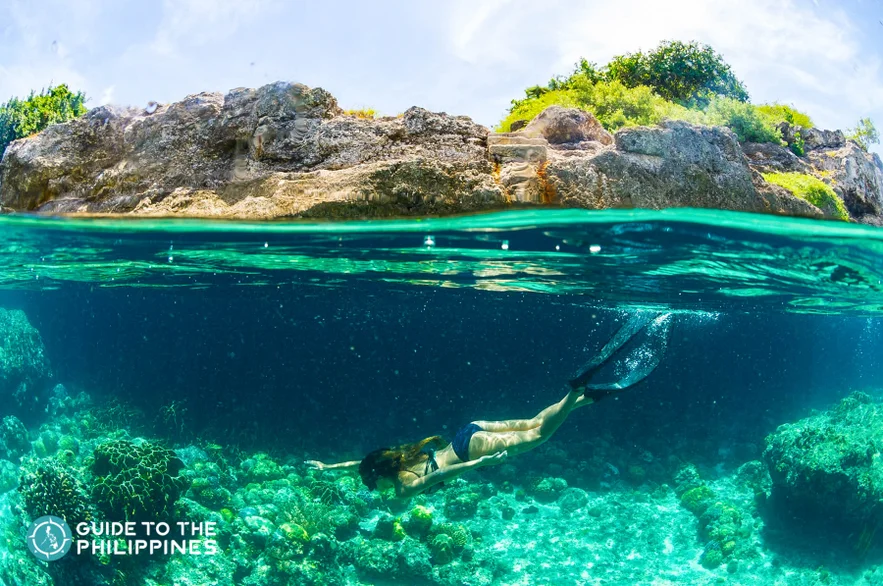
The main attraction of Moalboal is a million sardines hanging out in the shallow waters. Other than that the beautiful diving around Pescador Island is just 30 minutes away.
Panagsama Beach – Along with the millions of sardines, performing an underwater ballet, giant frogfish might be found together with rooftop pipefish and ringed pipefish.
Tongo Point – Schools of razorfish, crocodile needlefish, purple & threadfin anthias are to be found while reef squids and spadefish are making their way home. Green sea turtles and hawksbill turtles are also commonly seen here.
Turtle Bay – This site is often dived during the night dives where we can spot sleeping turtles along with different kinds of crabs and shrimps.
Dolphin House – Crocodile needlefish, drummers, milkfish, and yellowtail barracudas are living just under the surface while zillions of damsels and anthias are darting around the coral reef top.
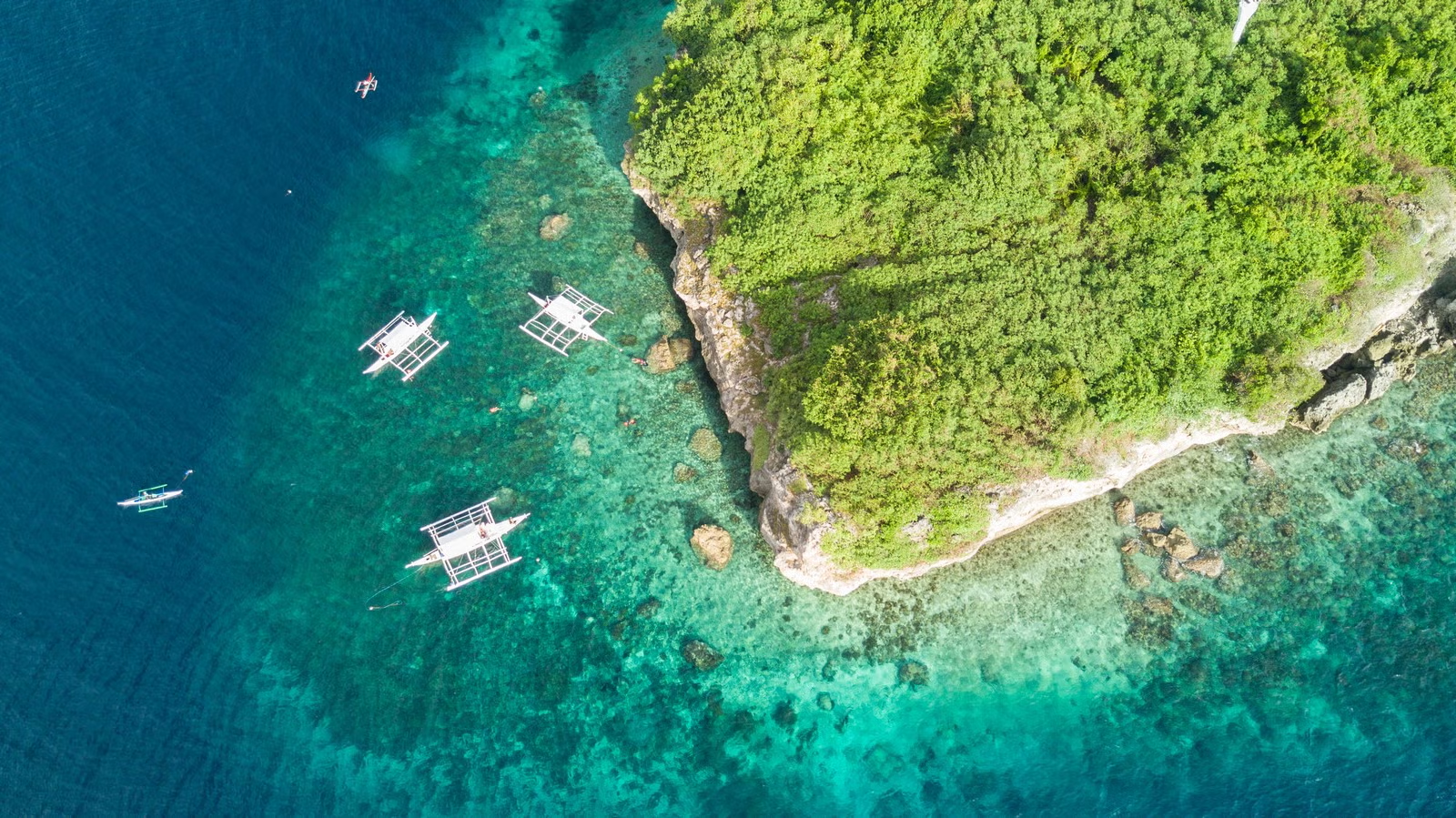
Just 30 minutes away from Moalboal this island is a perfect place to explore the dramatic steep walls and the colorful and lively reef top. Zillions of damsels, anthias, and Chromis are darting around while schools of fusiliers, red tooth triggerfish, surgeonfish, long-jawed mackerel, juvenile convict fish, and big-eyed trevallies are filling the blue. Pescador Island is also home to a couple of giant frogfish. The big cave on the northwest side of the island is a nice gimmick for the dives.
The whale shark encounter, where the whale sharks get hand-fed, can be done by diving or snorkeling, subject to additional fees payable at the destination. Please be advised it is not allowed to use strobes and/or flashlights here.

Apo Island Marine Reserve is one of the most successful marine sanctuaries to be established in the Philippines. Night diving is unfortunately not permitted however a sunset dive at The Chapel provides a superb opportunity to watch mandarin fish mating. The order of dives will be based on the currents and conditions of the day choosing from:
Coconut Point – An often fast-paced drift brings divers over the sloping coral reef wall. Along the way, giant trevally, blackfin barracuda, a big school of big-eyed trevally, and plenty of sea snakes can be encountered.
Rock Point West – Just beyond the chapel opposite the marine park warden’s office, Rock Point offers some of the most stunning hard corals to be found in the region. The steep reef walls support numerous colorful reef species – pyramid butterflyfish and red-toothed triggerfish are here in their hundreds, and frogfish, cuttlefish, banded sea snakes, and hawksbill turtles are amongst the common sightings.
Cogon– The colorful bottom divided by sand channels is the place to find a big school of big-eyed trevally, huge brown marbled groupers, and sea snakes.
Dauin, Negros
![]()
Dauin, with its black volcanic sand, is famous for muck diving. Depending on the season different types and sizes of octopuses, sea horses, (baby) frogfish, different kinds of ghost pipefish and flamboyant cuttlefish can be found.
The Cars – Between 25-30m (80-100ft), car parts as an artificial reef are attracting porcelain crabs and different kinds of shrimps among the many weird and wonderful creatures found at this site.
Secret Corner – This dive site contains sand and pebbles only and is the perfect habitat for the smallest, weird, and unexpected creatures as cockatoo wasp fish, shortfin lionfish, and snake and garden eels.
Ceres – They named this dive site after the local bus company that donated its tires to create an artificial reef, which attracts schools of reef fish. Different kinds of shrimps like to live on this reef together with juvenile reef fish.
Mainit – This dive site is a mix of coral boulders with soft corals and black volcanic sand. Probably due to the current, all fish are very active which makes this dive very lively and exciting ending in an area with hot sand at the bottom, hence the name Mainit meaning ‘hot’.

San Miguel – Another critter wonderland! When it is the right season, this is the place to find all your favorites.
Balicasag Island
The small island of Balicasag, just off the tip of Panglao, is characterized by its many turtles, coral gardens, and steep walls which provide overhangs cracks & crevices in which to search for a variety of marine species. This area has become a marine protected area since July 2017 and allows two dives per day only with valid permits.
Divers Heaven – The main attraction of this beautiful dive site is the green sea and hawksbill turtles in the shallow waters. The reef top edge is a nice habitat for schools of colorful damsels and anthias and when lucky also for giant frogfish.
Black Forest – Once famed for its black coral is where we encounter schools of jacks, long-jawed mackerels, red tooth triggerfish, and different kinds of fusiliers.
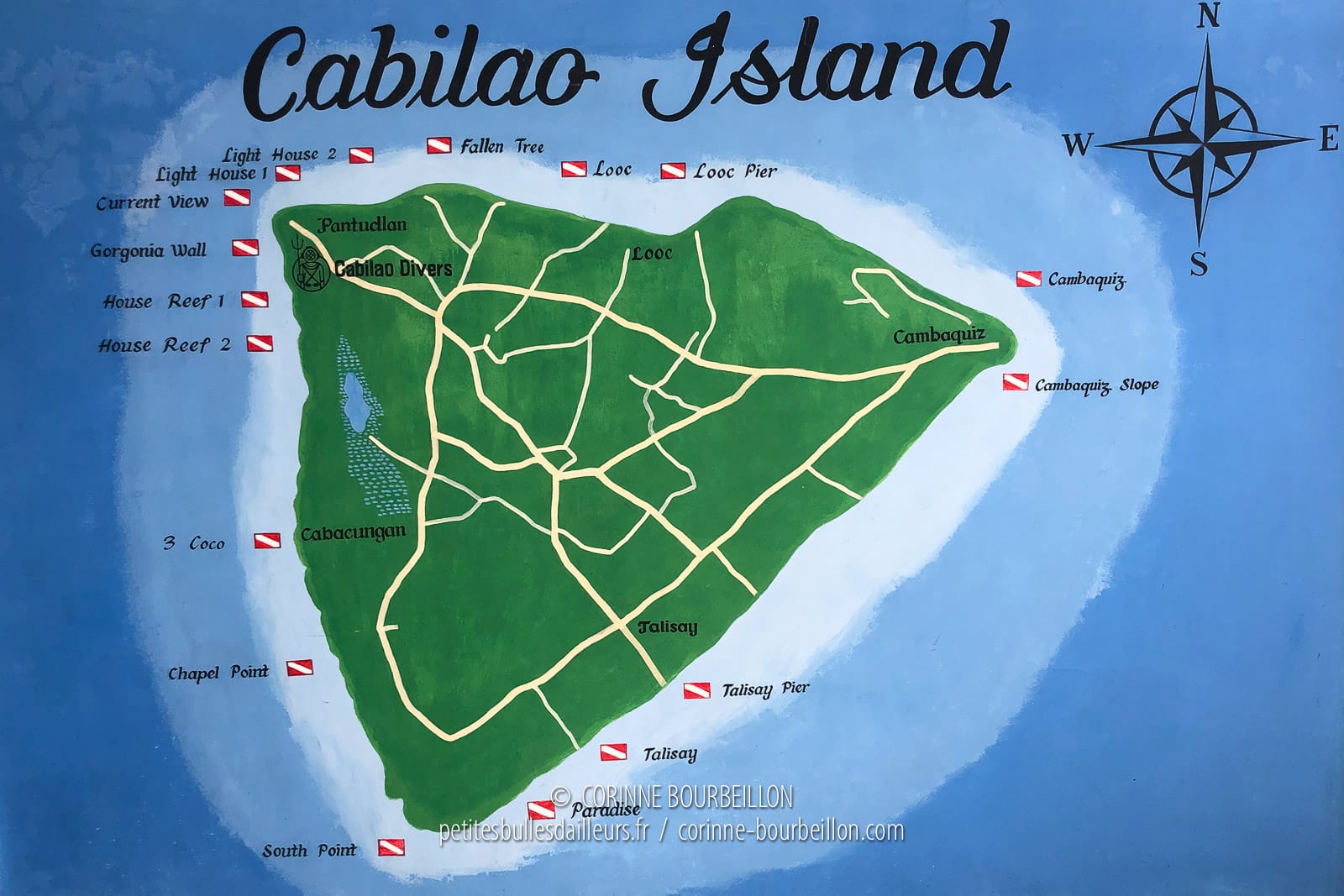
There are several interesting walls and coral garden dives around the island of Cabilao and we choose from the following:
Gorgonian Wall – Provides a gentle drift along a fantastic coral reef with schooling fish and plenty of macro life in the shallow water, including the possibility of spotting Denise’s pygmy seahorse.
Lighthouse – Sloping walls were full of sponges and gorgonian fans. This is a great place to dive with large green turtles. Also being seen are giant frogfish which can be spotted resting on sponges and numerous cowries hiding amidst the stunning hard coral garden.
Talisay Tree – Beautiful wall with gorgonians where bubble coral shrimps and orangutan crabs can be found in the bubble corals. The shallow grassy garden with its elephant ear sponges and barrel sponges is a perfect spot for wide-angle photography.
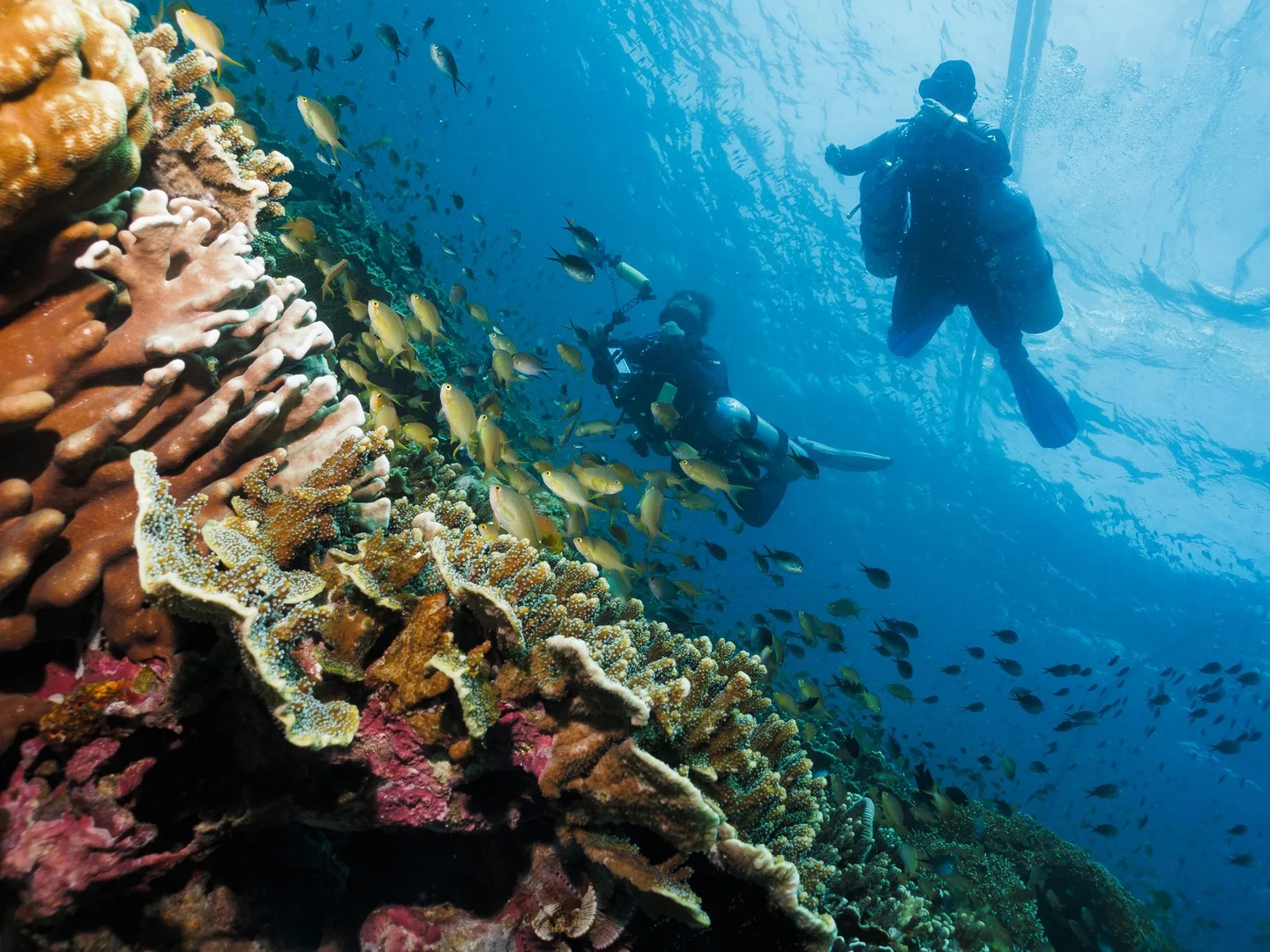
Cambaquiz – A fantastic spot where we often make night dives. A gently sloping reef and sandy bottom to 20 m – soft corals and sea pens can be found dotted over the sand; also a great site for sightings of bottom dwellers. The grassy top is a favorite crab hideout.
Embarkation is normally at 13:00 but sometimes can differ. Double-check your cruise confirmation for the exact time. Disembarkation at the end of the cruise will be just before 10 am, though you may be able to disembark earlier depending on your return flight arrangements. Please note this may affect the number of dives you can make on your final cruise day. Any early departures must be confirmed with our office prior to booking your flights. If traveling onwards on the same day, please allow plenty of time for transfer to international terminals and check-in.
Southern Visayas (Mactan – Mactan)

Day 1: Embarkation at 13:00
IMPORTANT NOTE: Strict adherence to the embarkation time is crucial. Please arrive at the port before 13:00H. After checking in and the safety briefing, the vessel will pull anchor and set sail.
Days 2-6: Up to 4 dives (3-day dives and a sunset or night dive), typically scheduled as follows:
- Light Breakfast followed by a briefing and Dive 1
- Full Breakfast, relaxation period, briefing, and Dive 2
- Lunch, relaxation period, briefing, and Dive 3
- Snack relaxation period, briefing, and Dive 4, where possible
- Dinner
Day 7: Maximum 2 dives
Day 8: Disembarkation at 10:00
Embarkation is normally at 13:00 but sometimes can differ. Double-check your cruise confirmation for the exact time. Disembarkation at the end of the cruise will be just before 10:00, though you may be able to disembark earlier depending on your return flight arrangements. Please note this may affect the number of dives you can make on your final cruise day. Any early departures must be confirmed with our office prior to booking your flights. If traveling onwards on the same day, please allow plenty of time for transfer to international terminals and check-in.
Malapascua & Visayas (Mactan – Mactan)

Sample Itinerary
Day 1:
Embarkation at 13:00, followed by lunch and briefings. If time allows, there may be a check dive scheduled, but diving on embarkation day is not guaranteed.
Days 2-9:
Your Cruise Director will schedule up to 4 dives per day: 3 day dives and a sunset or night dive. A typical diving day is scheduled as follows:
- Light Breakfast followed by a briefing & Dive 1.
- Full Breakfast, relaxation, followed by briefing & Dive 2.
- Lunch, relaxation, followed by briefing & Dive 3.
- Snack.
- Briefing for Dive.
- Dinner.
Day 10:
Usually 2 morning* dives before Philippine Siren commences the cruise back to the marina.
Day 11:
Following breakfast on board, disembarkation is scheduled for between 09:30 and 10:00.
Marine Life: Thresher Sharks, Manta Rays, White Tips, Turtle, Frogfish, Pipefish, Nudibranchs, Flamboyant Cuttlefish, Mandarin Fish, Whale Sharks.
The last dive of the trip will be on the penultimate day. Divers are recommended to wait for 24 hours before flying after the last dive.
Our reviews:
Home » Palawan » Boat Trips Tours »
You may also like:
We are a family operation managing private custom boat tours in the beautiful Palawan area, and are happy to help travelers with their plans through the country, having traveled a lot of it ourselves and planning to visit it all.










